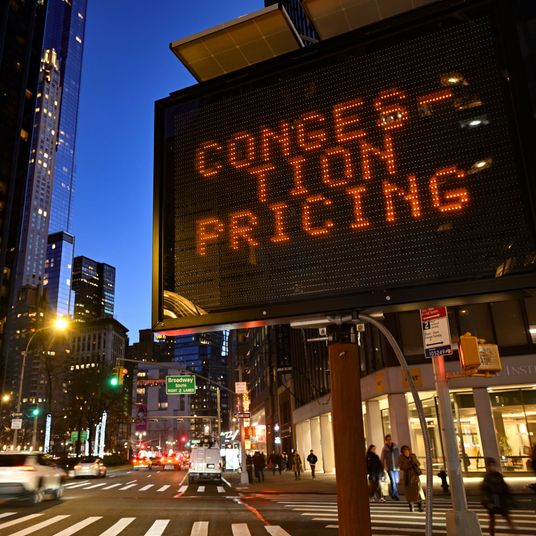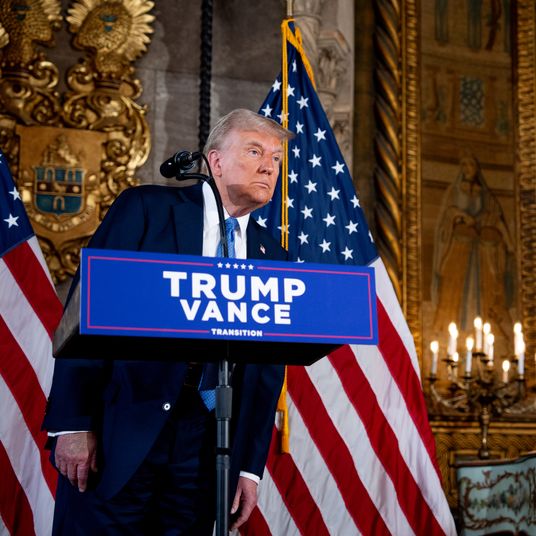
Everyone knows President Trump has decided getting his party’s conservative base riled up and “energized” is the GOP’s best hope to hang onto power in Congress. And that’s no surprise. Not only is it what he does best, day in and day out, with his tweets, his George Wallace–style rallies, and his constant provocations to the media and Democrats. It also accords with often-heard, simplistic truisms of midterm elections being “all about turnout” or “all about which base shows up.”
Those truisms contain a large kernel of truth. Turnout is so much lower in midterms than in presidential contests that mobilizing voters who will cast a ballot for you if they go to the polls is lower-hanging fruit than reaching and persuading swing voters, who are often the least likely to participate. In this period of maximum partisan and ideological polarization, moreover, the number of swing voters has declined significantly. And it’s much easier to appeal simultaneously to base and swing voters by making one’s opponents seem repellent or extremist than by rational arguments or bipartisan gestures.
But too much partisan heat does have its downside, particularly when the heat-generator is as unpopular outside his base as the president is right now. As Ron Brownstein points out, Trump’s strategy may be backfiring in the 25 Republican-held House seats that did not vote for POTUS to begin with:
[P]ublic and private polling suggest that nine of these seats—all of them centered in the suburbs—are already virtually lost causes for the GOP. That list starts with the incumbents Mike Coffman, near Denver; Erik Paulsen, near Minneapolis; Kevin Yoder, near Kansas City; and Barbara Comstock, in Northern Virginia (though some Republicans insist, against the public-polling evidence, that her campaign still has a pulse). Republicans have also largely written off open seats in Clinton-won districts near San Diego, Tucson, and Philadelphia, and in Pennsylvania’s Lehigh Valley.
Democrats are slightly favored in five other Clinton-Republican districts, including the incumbents Jeff Denham in the Central Valley, Steve Knight and Mimi Walters near Los Angeles, and Leonard Lance in New Jersey. The Democratic candidate is also favored in one open seat in the Miami area. (All but Denham’s district are urban-suburban seats.)
The remaining six races, all suburban-centered, look like pure toss-ups, with competitive challenges against the incumbents Peter Roskam outside Chicago; John Culberson and Pete Sessions in Houston and Dallas, respectively; and Dana Rohrabacher in Orange County. Also toss-ups are open seats in Orange County and Seattle.
Only five GOP incumbents in districts Clinton carried — David Valadao of California, Carlos Curbelo of Florida, John Katko of New York, Brian Fitzpatrick of Pennsylvania, and Will Hurd of Texas — seem to be leading in their races. Republican peril extends to a couple of dozen districts Trump carried narrowly in 2016 (one is the First Congressional District of Iowa, whose GOP incumbent, Rod Blum, has been all but abandoned by the national party).
In the Clinton-carried districts, particularly in the suburbs, Trump is, simply put, a millstone for Republicans.
A new Washington Post/Schar School poll across 21 of the 25 Clinton-won districts found that Trump’s approval rating in them stood at just 38 percent. Trump’s position in these swing districts was especially bleak among college-educated white voters, according to previously unpublished results provided to me by the Post’s polling director, Scott Clement. Not only did a staggering 70 percent of college-educated white women in these districts disapprove of Trump’s performance, but so did 58 percent of college-educated white men, usually a reliable Republican constituency.
Republican candidates in these areas can try to establish an identity distinct from their toxic president, but that’s always tough in midterms, and even more difficult with a president like Trump, who dominates the airwaves and the internet to an extent never seen before. And when that same omnipresent POTUS ratchets up his rhetoric to a deafening roar of demagogic partisanship, driving his MAGA legions into a hate rage against immigrants and minorities and the media, it’s almost impossible for an old-school reasonable Republican to break through the noise. And most don’t even try any more.
It’s possible that Trump’s strategy will help even in swing districts if his devotees show up en masse. But in contrast to 2016, Democrats are super-energized as well. Serving up big platters of red meat could work in places where Republicans already have significant numerical advantages and just need to pay attention to win. In more marginal territory, it’s a recipe for defeat.






























